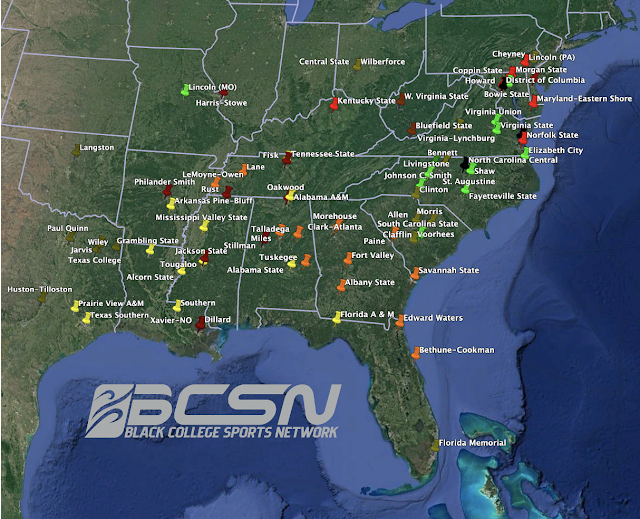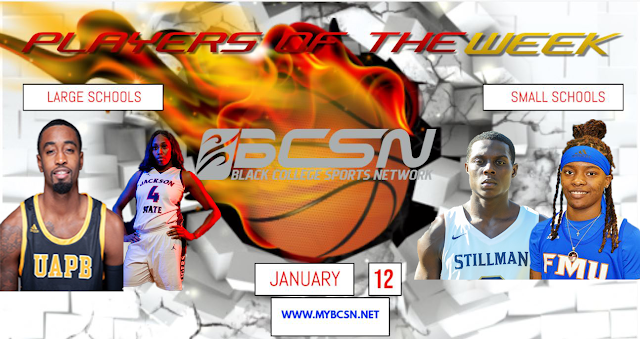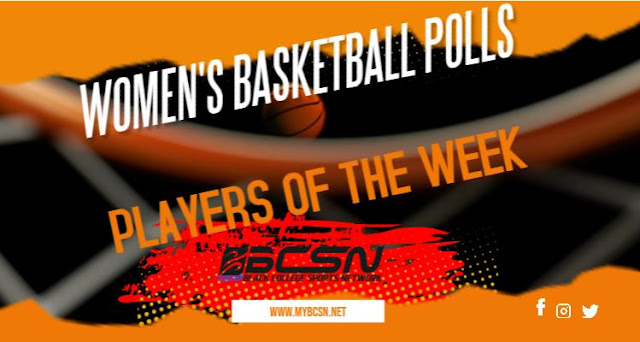CONFERENCE REALIGNMENT NEEDED FOR HBCUS
Originally published April 28, 2020 to the Black College Sports Network news
by A.D. Drew | BCSN Sportswrap Co-host
CONFERENCE REALIGNMENT NEEDED FOR HBCUS
The COVID-19 pandemic thus far has and will continue to force a sense of reality on college sports fans. The economic and logistics of how we evaluate the business model of HBCU sports will change as we face our new normal. Questions about whether we will have college sports (football specifically) and in what shape and form are among us. The Power 5 schools and Group of 5 schools are creating their own plans around football. Throw in the Mid-Majors in basketball, and the landscape will begin to shift, possibly faster than what experts have been forecasting for the future. Maybe it’s time for our HBCUs to ask some important questions about their future and look at some conference realignments by size, geography, and logic. The thoughts and ideas below are purely mine and not based on any inside information.
WHAT HAS HAPPENED SO FAR
Hampton left the MEAC for the Big South in 20181. Savannah State left the MEAC for the SIAC in the following year2. North Carolina A&T will join the Big South in 20213. Edward Waters is playing an SIAC schedule as they transition from NAIA to the SIAC of the NCAA4. Southern-New Orleans has temporarily dropped athletics5.
FUTURE OF SWAC
The Southwestern Athletic Conference is the premier Division I HBCU Conference and may be only one who survives long term. There are currently 10 members, divided into two divisions for football. Two schools have consistently been rumored to join this conference for years: Tennessee State and Florida A&M.
Tennessee State is a natural fit geographically in the conference and has a natural rival within the conference in Jackson State. The SWAC has courted Tennessee State in the past and probably will do it again. Alabama A&M and Alabama State will quickly become rivals along the I-65 corridor6. TSU was mandated by its state government 40 years ago to increase its diversity, which partially led to the decision to join the Ohio Valley Conference once upon a time7. Likelihood of happening: 20%.
Florida A&M has been rumored to join the SWAC for at least the past 10 years. In fact, FAMU could already be in the SWAC, but it decided to join the MEAC in 1979. FAMU was an independent in the mid-80s and most recently in 2004 when it attempted to become the first HBCU to join the FBS. After they abandoned their dream of playing with the big boys, they explored joining the SWAC but ultimately rejoined the MEAC. A report released by the Rattler’s athletic department in 2014 suggested that they join the SWAC8. And the rumors have never stopped. With the instability of the MEAC over the past 3 years, FAMU may be considering a move once again9. A move to the SWAC, not only is logical, but probable. Likelihood of happening: 80%.
A second team will need to follow FAMU to balance out the schedule. I honestly believe that if FAMU comes, TSU will join, but here are the alternatives.
- The logical choice from the MEAC is Bethune-Cookman. BCU is FAMU’s natural rival and the logical choice. The Florida Classic remains intact, as is, with this move. But Bethune is facing an $8 million deficit and cannot afford to make the move, given their financial woes.
- South Carolina State is on the list, but they are facing similar financial troubles and are trying to increase enrollment to increase revenue.
- The most stable school remaining that could be justified in North Carolina Central. Given the size of enrollment at Central10 and with rival North Carolina A&T gone to the Big South, Central will be looking to make the best move possible for themselves and stay at the Division I level. Imagine the SWAC Eastern Division featuring Alabama State, Alabama A&M, Alcorn State, Florida A&M, Jackson State, and North Carolina Central. Likelihood of happening: 50%.
 |
| Projected future of SWAC |
FUTURE OF MEAC
A move of FAMU and NCCU to the SWAC will eliminate the MEAC as a major player on the Division I level. There may be many reasons why NCAT and Hampton left and others may be considering leaving, but Howard may be on an island by themselves within the conference11. Howard becomes the clear leader of the conference and will probably get pulled away by the Big South. The benefit of having 3 HBCUs will be huge for the Big South. Unfortunately, this move will essentially kill the MEAC as we know it.
Assuming Howard heads to the Big South, this conference will have to become a Division II conference or dissolve. Almost half of the remaining MEAC schools are dealing with some type of financial issue, some more serious than others. These schools include Bethune-Cookman12, Coppin State13, and South Carolina State14,15, and to a lesser extent, Morgan State.
South Carolina State (50%) and Bethune-Cookman(70%) may be headed towards Division II for survival. Delaware State, Morgan State, and Norfolk State will become football independents (no matter what level they play) leaving Maryland-Easten Shore and Coppin State in all other sports. It has even been rumored that the CIAA has approached Norfolk State about returning16. If this conference is to survive at Division II, they need to look at adding Lincoln (PA) and the University of the District of Columbia. Other schools on my list, as a Division II Conference, are Bluefield State, West Virginia State (not likely going to move), Central State (40%) or Kentucky State (40%).
 |
| Projected future of MEAC |
FUTURE OF CIAA
Under my scenarios, Lincoln (PA) will join the Division II version of the MEAC. Their replacement is easy: South Carolina State. SCSU is a much better fit within the footprint of the CIAA. As the school is facing financial issues, athletic travel is limited to the Carolinas, Virginia, and Maryland for conference play. Throw in the fact that Clafflin is across the street in Orangeburg, this move is natural. If this happens, the CIAA can maintain their status and continue to put on the best basketball tournament in the nation. Likelihood of happening: 50%.
 |
| Projected future of CIAA |
FUTURE OF SIAC
Losing the two most northern schools, who play in the West Division but are on Eastern Time, to the new MEAC will not hurt this conference. Spring Hill, the only Predominantly White Institution (PWI) that is a full-time member of an HBCU conference, were charter members of the Gulf Coast Athletic Conference17. Edward Waters is working towards membership and plays a SIAC football schedule currently. Savannah State's recent success moving backwards to Division II should inspire Bethune-Cookman to move backwards also. There will be a great rivalry along I-95 between Savannah State, Edward Waters, and Bethune-Cookman. Likelihood of happening: 60%.
One additional chip must fall to keep the SIAC balanced if Kentucky State and Central State leaves. Another school needs to be added in the West Division for balance. With no other Division II team in the Western footprint, an NAIA school will have to move up. Talladega College, an original member of the SIAC, may want to return18. In Alabama, they would have two natural rivals, Miles (1 hour away) and Tuskegee (2 hours away). West Division opponent Lemoyne-Owen is less than 4 hours away. Current East Division teams Morehouse and Clark-Atlanta are less than 2 hours away and would need to move to the West Division. The addition of Talladega and the loss of Kentucky State and Central State gives the SIAC two 7-team divisions. Likelihood of happening: 75%.
 |
| Projected future of SIAC |
THE OTHERS-NCAA
Lincoln (MO) had provisional membership in the SIAC in the early 2000s19,20. The next closest team within the SIAC conference is almost 7 hours away (Lane). Travel for this team would be a major issue. They will most likely remain members of their current conference, the Mid-American Intercollegiate Athletic Association. For the other teams not mentioned here, we are assuming that the teams not mentioned here will remain in their current conference.
FUTURE OF GCAC
Southern-New Orleans has temporarily suspended athletics. Edward Waters is working to move to the SIAC. I have laid out a scenario in which Talladega moves to the SIAC also. That leaves the GCAC with only 5 teams. Immediate expansion is a must.
The first logical choice is former member Fisk, who was a member of the conference from 2010-201421. The Bulldogs lie just outside of the current footprint of the conference, but fit in much better than Edward Waters in Jacksonville, FL. Fisk’s return brings the GCAC up to 6 teams. Likelihood of happening: 50%.
In order to get back to Alabama, the GCAC needs to add Stillman22. The Tigers are located in Tuscaloosa and are just up the road from current member, Talladega. The addition of Stillman would push the conference to seven teams and keep the conference in Alabama. Stillman was supposed to join the conference when they dropped from NCAA to NAIA in 2015, so now is as good of a time as any23. Likelihood of happening: 40%.
To bring the conference to eight teams, the conference will have to stretch. Oakwood University in Huntsville, AL fits within the conference geographically, but is currently an USCAA team. This is the best fit for the conference but is the school willing to move fully to the NAIA? Likelihood of happening: 20%.
There are three other candidates if the conference wants to remain exclusively HBCU and travel: Voorhees, Harris-Stowe and Florida Memorial. Voorhees is a former member but the travel to New Orleans, Arkansas, and Mississippi would be extensive24. Given the distance from New Orleans to Miami Gardens vs. the distance from New Orleans to St. Louis, Harris-Stowe is more logical than Florida-Memorial. Either way, the chances of one of these becoming the eighth team being are slim, but not none. Likelihood of happening: 10%.
 |
| Projected future of GCAC |
THE OTHERS-NAIA
The Red River Conference, which is based in Texas, is a mixed conference with both PWIs and HBCUs. The conference currently contains 5 HBCUs: Huston-Tillitson, Jarvis, Paul Quinn, Texas College, and Wiley College. It would be nice if Langston rejoined this conference25 for all sports except football (the conference does not sponsor football).
Langston currently competes in the Sooner Athletic Conference and Texas College joins them for football only. Langston appears to be happy in the Sooner Athletic Conference, but once upon a time, they were in the SWAC26, and were provisional members of the SIAC19 (early 2000s) and recently changed conferences (2018). Likelihood of happening: 10%.
There are a cluster of NAIA Division II or USCAA teams based in the Carolinas that could form a conference: Allen, Bennett, Clinton, Morris, and Voorhees. Throw in Virginia-Lynchburg, and you have a 6 team conference. These teams already tend to face each other on their basketball schedules, so why not create a conference and compete for a championship and an automatic bid to the tournament? Likelihood of happening: 30%.
Cheyney State and Wilberforce are on an island geographically as NAIA schools and the University of the Virgin Islands are literally on an island. These teams will have to continue doing what they are currently doing. For the other teams not mentioned here, we are assuming that the teams not mentioned here will remain in their current conference.
 |
| Projected future of HBCUs in Red River Conference |
 |
| Remaining NAIA Schools |
CONCLUSION
While I may have just presented some probable, logical, and hopeful suggestions, I also realized that I just killed the Celebration Bowl and the MEAC/SWAC Challenge, two of the largest events for HBCU football. But our lack of alumni giving, merchandise sales, ticket sales for anything other than “The Classic” or homecoming and sponsorships are hurting our institutions more than the Celebration Bowl or MEAC/SWAC Challenge are helping us overall. Things will change! Things must change!!!




Comments
Post a Comment